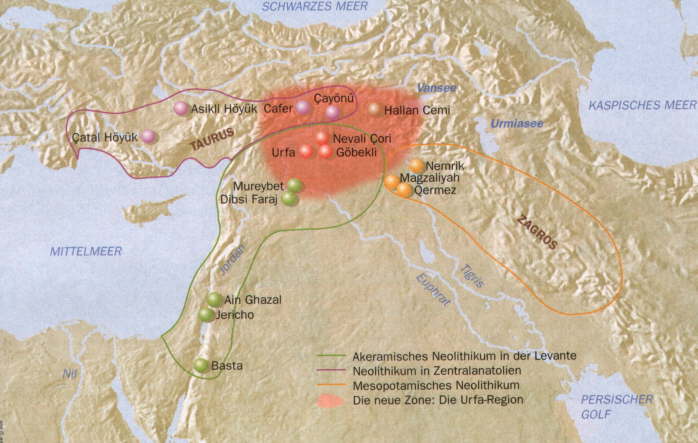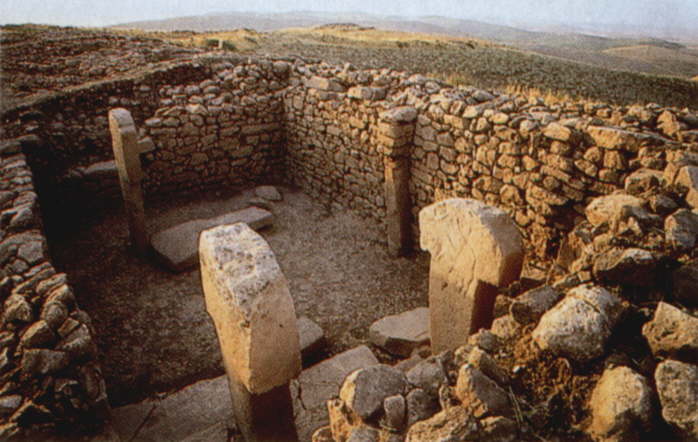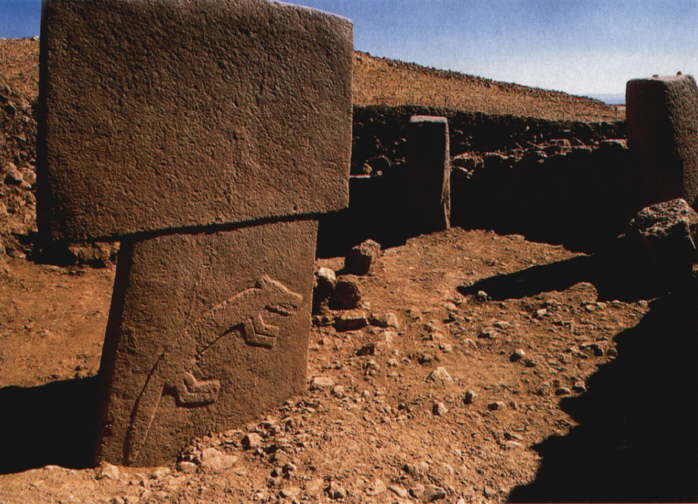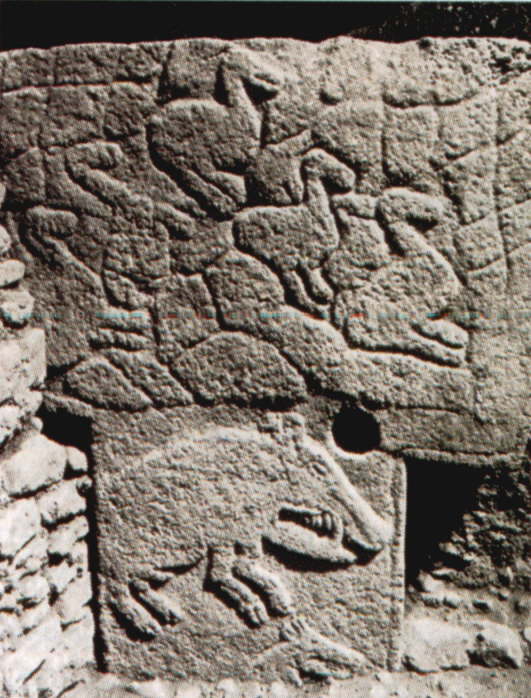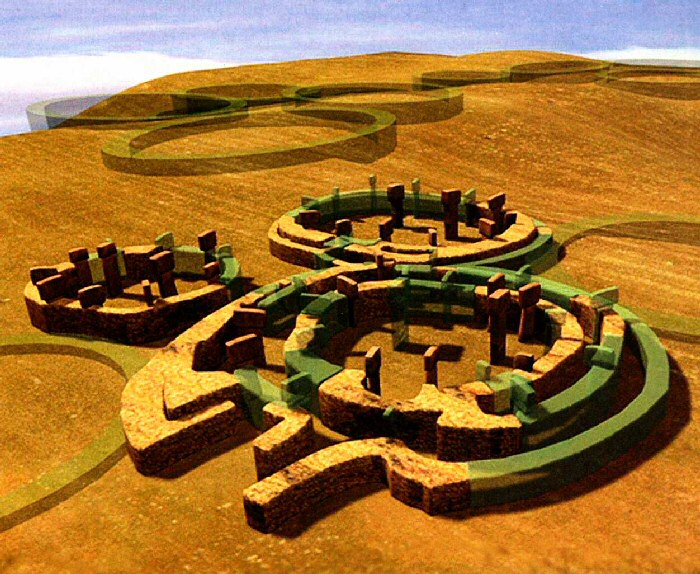 |
Bilder und
erklärende Texte
aus Bild der Wissenschaft 8/2000 und 1/2002
SOURCE: http://www.urgeschichte.org/DieBeweise/GobekliTepe/gobeklitepe.htm
Unbemerkt vom Rest der Welt wurde in Süd-Ost-Anatolien ein Wunder entdeckt: Die älteste Kultstätte der Welt - weit älter als das bisher als älteste Stadt gehandelte Jericho - wartet mit wunderbaren Tierskulpturen auf. Wie passt das zusammen, dass altsteinzeitliche Jäger und Sammler auf einer solch hohen kulturellen Entwicklungsstufe stehen?
Das ist jedenfalls Fakt - und Sitchin erläutert: Das Zweistromland war durch die Sintflut zerstört und unbewohnbar. Die Überlebenden siedelten sich auf den umliegenden Höhen an. Enlil übergibt den überlebenden Menschen der Sintflut Geräte und Samenkörner. Im Hochland beginnt die Landwirtschaft. Enki zähmt Tiere.
Fortsetzung aus Bild der Wissenschaft 5/2003
DER ÄLTESTE TEMPEL der Welt wird immer größer und gewaltiger. In der letzten Grabungskampagne haben Dr. Klaus Schmidt und seine deutschen und kurdischen Helfer in Ostanatolien 11 neue Riesenpfeiler freigelegt. Insgesamt sind es jetzt 36. Alle messen über drei Meter - mit zwei Ausnahmen: Diese Pfeiler werden fünf Meter hoch sein, wenn sie komplett ausgegraben sind. Damit sind sie so groß wie die Monolithe von Stonehenge - nur sind die Kalksteinkolosse im osttürkischen Bergland 6000 Jahre älter.
Vor 11.000 Jahren, am Ende der Altsteinzeit, schufen Jäger und Sammler auf dem Göbekli Tepe („Nabelberg") ein komplexes Kultzentrum, zu dem es bis heute keinen Vergleich gibt (bild der wissenschaft 1/2002, „Das Haus der Füchse"). Der Prähistoriker des Deutschen Archäologischen Instituts legte mehrere runde und rechtwinklige Räume mit bis zu 15 Meter Durchmesser frei - eine Monumentalarchitektur, die Wissenschaftler den „primitiven" Steinzeitgesellschaften bislang nicht zugestehen wollten.
Die Sensation jedoch sind die T-förmigen Pfeiler, die am Stück aus dem Kalkstein des Bergrückens gepickelt und auf planierten Terrazzoböden aufgestellt wurden. Sie stehen frei oder sind ins Mauerwerk eingebunden, die Hälfte ist mit Tierreliefs geschmückt: mit Füchsen, Löwen, Stieren, Enten, Keilern und Schlangen. Seit der letzten Kampagne bevölkern zusätzlich gazellenartige Onagaer und zwei Kraniche vor stilisiertem Wasser den steinernen Zoo.
Ein neu ausgegrabener Raum geht bis 4 Meter in die Tiefe und hat den gigantischen Innendurchmesser von 20 Metern. In dieser „Anlage C" massieren sich auf den Pfeilern die Darstellungen von Wildschweinen. Schmidt: „Hier haben Leute agiert, die eine besondere Vorliebe für Keiler hatten." Bislang tauchten Füchse am häufigsten auf.
Erklären kann Schmidt das Wildschwein-Gedränge ebenso wenig wie die - ebenfalls einmaligen - Piktogramme auf den Pfeilern. Rätselhaft bleibt wohl für immer, warum die Steinzeitler ihren Tempel sorgfältig zuschütteten. Diesem Umstand verdankt Schmidt die nun gesicherte Datierung seines Wunderbaus: Mit einer geochemischen Methode kann die Versinterung der Steine zeitlich bestimmt werden. Die setzte erst ein, als das Mauerwerk bedeckt war, also nachdem die Anlage zugeschüttet worden war.
Babelfish Translation:
Pictures and explaining texts from "Bild der Wissenschaft" 8/2000 and 1/2002
Unnoticed by the remainder of the world in south east Anatolien a miracle was discovered: The oldest place of worship in the world - far older than oldest city now listed, Jericho - offers marvelous animal sculptures. How does that fit that old-stone-temporal hunters and collecting tank stand on such high cultural entwicklungsstufe?
That is
anyhow fact - and
Sitchin describes: The two-current country
was destroyed and uninhabitable
by the sintflut. The survivors settled on
the surrounding heights. Enlil
hands over to humans of the sintflut of
devices and grains the survivors.
In the high country the agriculture begins.
Enki zaehmt animals.
Continuation
from picture
of the science 5/2003
The OLDEST TEMPLE of the world continues to increase and more enormous. In the last excavation campaign Dr. Klaus Schmidt opened and its German and Kurdish aid in Ostanatolien of 11 new giant columns. Altogether there is now 36. All measure over three meters - with two exceptions: These columns will be high five meters, if they are completely excavated. Thus they are as large as the Monolithe of Stonehenge - only the Kalksteinkolosse is 6000 years older in the eastTurkish mountain country.
Before 11,000 years, at the end the paleolithic age, created hunters and collecting tanks on the Goebekli Tepe ("navel mountain") a complex cult center, to that it to today no comparison gives (picture of the science 1/2002, "the house of the foxes"). The Praehistoriker of the German archaeological institute opened several round and right-angled area with up to 15 meters of diameters - a monumental architecture, which scientists did not want to grant to the "primitive" stone time companies so far.
The sensation however are the t-shaped columns, which were gepickelt at the piece from the limestone of the ridge and set up on planed Terrazzoboeden. They are open or are merged in the brick-work, half are decorated with animal reliefs: with foxes, lions, bulls, ducks, Keilern and queues. Since the last campaign additionally gazellenartige Onagaer and two Kraniche before representative water populate the stone zoo.
A newly excavated area goes up to 4 meters into the depth and has the gigantic inside diameter of 20 meters. In this "plant C" the representations of wild pigs concentrate themselves on the columns. Schmidt: "here people acted, the one special preference for Keiler had." So far foxes emerged most frequently.
To explain Schmidt knows the wild pig crowding just as little as - likewise unique - the pictograms on the columns. Probably always it remains puzzling why the Steinzeitler filled up its temple carefully. Schmidt owes the secured dating of its building of miracles to this circumstance: With a geochemical method the sintering of the stones can be determined temporally. Those used only, when the brick-work was covered, thus after the plant had been filled up.
Google Translation:
Unnoticed by the rest of the world found in South-Eastern Anatolia a miracle: The oldest place of worship in the world - far older than the previously traded as the oldest city Jericho - comes up with wonderful animal sculptures. How does that work, that paleolithic hunters and gatherers are at such a high cultural level of development?
At least that's a fact - and Sitchin explains: The land of two rivers was destroyed by the flood and uninhabitable. The survivors settled on the surrounding heights. Enlil passes to the surviving people of the deluge equipment and seeds. In the high country begins to agriculture . Enki domesticates animals.
Continued
from Bild der Wissenschaft
5 / 2003
THE
OLDEST TEMPLE of the
world is getting bigger and more powerful.
In the last season of excavations,
Dr. Klaus Schmidt and his German and Kurdish
workers in eastern Anatolia,
have unearthed 11 new giant pillars. In
total there are now achieving 36
All measure about three feet - with two
exceptions: These pillars will
be five feet high when they are fully
excavated. Thus, they are as big
as the monoliths of Stonehenge - are the
only limestone colossi in eastern
Turkey hill country 6000 years older.
11,000 years ago, at the end of the Paleolithic hunters and gatherers created on the Göbekli Tepe ("navel hill"), a complex religious center, to which there is still no comparison (Bild der Wissenschaft 1 / 2002, "The House of foxes"). The prehistory of the German Archaeological Institute uncovered several circular and rectangular areas with up to 15 meters in diameter - a monumental architecture, the scientists the "primitive" stone age societies not previously wanted to admit.
The sensation, however, the T-shaped pillars that were pickled in a row from the limestone of the mountain ridge and placed on leveled terrazzo floors. You are free standing or integrated into the walls, half is decorated with animal reliefs with foxes, lions, bulls, ducks, wild boars and snakes. Since the last campaign also populate gazelle-like Onaga and two cranes in the water stylized stone zoo.
A newly excavated space goes up to 4 meters in depth and has a huge internal diameter of 20 meters. In this "Appendix C" massage on the pillars of the representations of wild boar Schmidt. "Here, people have acted, had a special fondness for wild boar." So far, foxes appeared most frequently.
Schmidt
can explain the wild
boar as little as the crowd - also unique -
icons on the pillars. Puzzling
is probably for ever, why the stone temple
zuschütteten Zeitler their
care. For this reason that Schmidt is now
dating his miracles secured building:
With a geochemical method, the sintering of
the stone will be timed. The
only began when the wall was covered, so it
was after the plant has been
filled.

